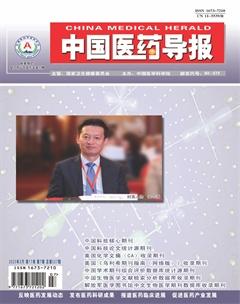颅骨成形术的研究进展
刘百雨 王忠
[摘要] 本文从颅骨成形术的必要性、术后并发症、修补材料、修补时机等方面对颅骨成形术的研究进展进行了回顾和分析。颅骨成形术对于存在有颅骨缺损的患者来说是必要的而且可以提高其生存质量。颅骨成形术的常见并发症包括硬膜外血肿、皮下积液积血、头皮切口感染、颅内感染、修补材料外露及颅骨成形术后癫痫发作。早期颅骨修补相比于传统修补存在诸多益处,其时机需根据疾病种类的不同和患者情况进行选择;修补材料负载药物技术和羟基石灰石骨替代技术的发展使临床工作人员在材料的选择上有了更多更好的选择;计算机辅助设计和制造(CAD/CAM)等技术使自体颅骨得以在应用中展示其独特的优点。本文对颅骨修补术在临床上的应用提供了参考。
[关键词] 颅骨成形术;并发症;术后癫痫;修补材料
[中图分类号] R651 [文献标识码] A [文章编号] 1673-7210(2020)03(a)-0035-04
[Abstract] This article has reviewed and analyzeed the research progress of cranioplasty from the aspects of necessity, postoperative complications, repair materials, and repair timing. Cranioplasty surgery is necessary for patients with skull defects and can improve their quality of life. Common complications of cranioplasty include epidural hematoma, subcutaneous effusion, scalp incision infection, intracranial infection, exposure of repair materials, and post-cranioplasty seizures. Compared with traditional repair, early skull repair has many benefits, and its timing needs to be selected according to the type of disease and the patient′s condition; the development of repair material-loaded drug technology and the development of hydroxylimestone bone replacement technology has given clinical staff the choice of materials more and better choices; technologies such as computer-aided design and manufacturing (CAD/CAM) allow autologous skulls to demonstrate their unique advantages in their applications. This article provides a reference for the clinical application of cranioplasty.
[Key words] Cranioplasty; Complication; Post-cranioplasty seizures; Repair materials
顱骨成形术是一种重建性手术,因其可恢复颅骨减压术后颅骨结构的完整性、改善因颅骨缺损导致的颅骨缺损综合征而被广泛应用[1]。当外伤性颅脑损伤或大面积脑出血引起的脑组织水肿最终发展成不能通过常规保守治疗措施来有效干预的恶性颅内压升高时,施行去骨瓣减压术(decompressive craniectomy,DC)是挽救患者生命的有效手段。脑部急性肿胀消退后,需进行颅骨成形术以恢复颅骨的完整性和改善局部脑组织血供及脑脊液动力学。这也是恢复患者心理社会功能并促进其术后康复的重要因素。
1 颅骨修补的必要性
颅骨减压术在挽救患者生命的同时,术后存留的颅骨缺损给患者带来了诸多不便。术后颅骨缺损的患者可表现为记忆力减退、敏感性增高、注意力不集中、头晕、头痛、易疲劳、易怒及焦躁、忧虑等相关心理和躯体症状,临床上称之为颅骨缺损综合征,即Trephined综合征[1]。一方面,颅骨成形术可以通过恢复颅腔的物理完整性从而为患者颅骨缺损部分提供有效保护来提高患者生存质量,在降低再次受到伤害可能的同时,内环境稳态的重新建立也使脑组织血流灌注得到改善。另一方面,因减压术后外观上的改变所带来的精神心理压力降随着修补术的结束而大大减轻。颅腔物理完整性的恢复对于患者神经功能恢复及预后而言也是一个有利的条件。
关于颅骨修补的必要性,颅骨成形术还在一些特殊病例被建议应用。Siegmund等[2]报道了1例成人慢性放射性皮肤炎伴颅骨放射性坏死的病例,指出对于放射性颅骨纤维化骨髓炎的患者,使成人慢性纤维化骨髓炎及颅骨放射性坏死是放射治疗的晚期并发症且并不常见,但是由此造成的大面积颅骨缺损仍需处理,以避免一系列并发症,提高患者生存质量。对于DC后患者常存在的头皮凹陷伴神经功能缺损。Park等[3]的研究指出,对于去骨瓣减压的患者应常规进行神经功能恶化监测,当出现头皮凹陷伴神经功能不全时患者应早期行颅骨缺损修补术。颅骨成形术同样被用在颅骨骨髓炎的治疗中,Kwiecien等[4]在回顾性分析了111例颅骨骨髓炎患者同种异体骨修补术后神经功能改善情况后提出,在清除了受感染的骨头之后,需对患者进行延迟颅骨修补以获得最大收益。法国学者Champeaux等[5]在对1841例恶性脑梗死后颅骨成形术患者长期生存及相关预后因素渐变分析中得出,DC患者在1年内行颅骨成形术,有助于保持良好的功能状态。对于各个年龄段存在颅骨缺损的患者,颅骨成形术是必要的而且可以提高患者的生存质量。
6 結论
目前,关于颅骨成形术的必要性已无可争议,对于各个年龄段存在颅骨缺损的患者,颅骨成形术是必要的而且可以提高患者的生存质量。对于颅骨修补时机来说,早期颅骨成形术存在诸多益处,关于早期修补术的时机,需根据疾病种类的不同和患者情况进行个性化选择。关于修补材料选择方面,修补材料负载药物技术和羟基石灰石骨替代技术的发展使临床工作人员在材料的选择上有了更多选择,使患者更多获益。随着VR可视技术及CAD/CAM技术的在颅骨成形术中的广泛应用,自体颅骨以其独特的优点,正受到越来越多的重视。
[参考文献]
[1] Yamaura A,Makino H. Neurological deficits in the presence of the sinking skin flap following decompressive craniectomy [J]. Neurol Med Chir(Tokyo),1977,17(1Pt1):43-53.
[2] Siegmund BJ,Rustemeyer J. Case report:chronic inflammatory ulcer and osteoradionecrosis of the skull following radiotherapy in early childhood [J]. Oral Maxillofac Surg,2019,23(2):239-246.
[3] Park HY,Kim S,Kim J,et al. Sinking Skin Flap Syndrome or Syndrome of the Trephined:A Report of Two Cases [J]. Ann Rehabil Med,2019,43(1):111-114.
[4] Kwiecien G,Aliotta R,Bassiri B,et al. The Timing of Alloplastic Cranioplasty in the Setting of Previous Osteomyelitis [J]. Plast Reconstr Surg,2019,143(3):853-861.
[5] Champeaux C,Weller J. Long-Term Survival After Decompressive Craniectomy for Malignant Brain Infarction:A 10-Year Nationwide Study [J]. Neurocrit Care,2019,9.
[6] 汤宏,张永明,许少年,等.颅骨成形术后并发症的临床分析及治疗策略(附158例报道)[J].中华神经创伤外科电子杂志,2017,3(1):17-20.
[7] 王忠,苏宁,吴日乐,等.标准大骨瓣减压术后早期颅骨修补的选择及并发症的临床分析[J].临床神经外科杂志,2014,11(5):360-362.
[8] 赵继宗.神经外科学[M].2版.北京:人民卫生出版社,2012:284-285.
[9] 王建军,孙炜,胡安明.颅骨成形术常见因素与并发症相关分析[J].中国现代医学杂志,2016,26(4):138-142.
[10] Honey S. Complications of decompressive craniectomy for head injury [J]. J Clin Neurosci,2010,17(4):430-435.
[11] Honeybul S,Morrison DA,Ho KM. A randomized controlled trial comparing autologous cranioplasty with custom-made titanium cranioplasty [J]. J Neurosurg,2017,126(1):181-190.
[12] Ferguson PL,Smith GM,Wannamaker BB. A population-based study of risk of epilepsy after hospitalization for traumatic brain injury [J]. Epilepsia,2010,51(5):891-898.
[13] Wang H,Zhang K,Cao H. Seizure after cranioplasty:incidence and risk factors [J]. Craniofac Surg,2017,28(1):e560-e564.
[14] Mukherjee S,Thakur B,Haq I. Complications of titanium cranioplasty—a retrospective analysis of 174 patients [J]. Acta Neurochir(Wien),2014,156(5):989-998.
[15] Shih FY,Lin CC,Wang HC,et al. Risk factors for seizures after cranioplasty [J]. Seizure,2019,66:15-21.
[16] Yao ZX,Hu X,You C. The incidence and treatment of seizures after cranioplasty:a systematic review and meta-analysis. [J]. Br J Neurosurg,2018,32(5),489-494.
[17] Chen CC,Yeap MC,Liu ZM,et al. A Novel Protocol to Reduce Early Seizures After Cranioplasty:A Single-Center Experience [J]. World Neurosurg,2019,125:e282-e288.
[18] Yeap MC,Chen CC,Liu ZH,et al. Postcranioplasty seizures following decompressive craniectomy and seizure prophylaxis:a retrospective analysis at a single institution [J]. J Neurosurg,2018,131(3):936-940.
[19] Rosenthal G,Ng I,Moscovici S,et al. Polyetheretherketone implants for the repair of large cranial defects:a 3-center experience [J]. Neurosurgery,2014,75(5):523-529.
[20] Shah AM,Jung H,Skirboll S,et al. Materials used in cranioplasty:a history and analysis [J]. Neurosurg Focus,2014,36(4):E19.
[21] Honeybul S,Morrison DA,Ho KM,et al. A randomised controlled trial comparing autologous cranioplasty with custom-made titanium cranioplasty:long-term follow- up [J]. Acta Neurochir (Wien),2018,160(5):885-191.
[22] Sundblom J,Gallinetti S,Birgersson U,et al. Gentamicin loading of calcium phosphate implants:implications for cranioplasty [J]. Acta Neurochir(Wien),2019,161(6):1255-1259.
[23] Kihlstrom Burenstam Linder L,Birgersson U,Lundgren K,et al. Patient-Specific Titanium-Reinforced Calcium Phosphate Implant for the Repair and Healing of Complex Cranial Defects [J]. World Neurosurg,2019,122:e399-e407.
[24] Beuriat PA,Lohkamp LN,Szathmari A,et al. Repair of Cranial Bone Defects in Children Using Synthetic Hydroxyapatite Cranioplasty (CustomBone) [J]. World Neurosurg,2019,129:e104-e113.
[25] Sakamoto S,Eguchi K,Kiura Y,et al. CT perfusion imaging in the syndrome of the sinking skin flap before and after cranioplasty [J]. Clin Neurol Neurosurg,2006,108(106):583-585.
[26] Bender A,Heulin S,R?觟hrer S,et al. Early cranioplasty may improve outcome in neurological patients with decompressive craniectomy [J]. Brain Inj,2013,27(29):1073-1079.
[27] Lin AY,Kinsella CRJ,Rottgers SA,et al. Custom porous polyethylene implants for large-scale pediatric skull reconstruction:early outcomes [J]. J Craniofac Surg,2012, 23(21):67-70.
[28] Van de Vijfeijken Secm,Groot C,Ubbink DT,et al. Factors related to failure of autologous cranial reconstructions after decompressive craniectomy [J]. J Craniomaxillofac Surg,2019,47(9):1420-1425.
[29] Bjornson A,Tajsic T,Kolias AG,et al. A case series of early and late cranioplasty-comparison of surgical outcomes [J]. Acta Neurochir (Wien),2019,161(3):467-472.
[30] Kim JH,Hwang SY,Kwon TH,et al. Defining “early” cranioplasty to achieve lower complication rates of bone flap failure:resorption and infection [J]. Acta Neurochir (Wien),2019,161(1):25-31.
[31] Wang JS,Ter Louw RP,DeFazio MV,et al. Subtotal calvarial vault reconstruction utilizing a customized polye-theretherketone (PEEK) implant with chimeric microvascular soft tissue coverage in a patient with syndrome of the trephined:A case report [J]. Arch Plast Surg,2019, 46(4):365-370.
[32] Sheng HS,Shen F,Zhang N,et al. Titanium mesh cranioplasty in pediatric patients after decompressive craniectomy:Appropriate timing for pre-schoolers and early school age children [J]. J Craniomaxillofac Surg,2019,47(7):1096-1103.
[33] Ye J,Zhang W,Ye M,et al. Using titanium mesh to replace the bone flap during decompressive craniectomy:A medical hypothesis [J]. Med Hypotheses,2019,129:09257.
[34] Zawy AS,Stroop R,Fusek I,et al. Early autologous cranioplasty:complications and identification of risk factors using virtual reality visualisation technique [J]. Br J Neurosurg,2019,13:1-7.
[35] Musavi L,Macmillan A,Lopez J,et al. Using Computer-Aided Design/Computer-Aided Manufacturing for Autogenous,Split Calvarial Bone Graft-based Cranioplasty:Optimizing Reconstruction of Large,Complex Skull Defects [J]. J Craniofac Surg,2019,30(2):347-351.
(收稿日期:2019-11-29 本文編辑:封 华)

